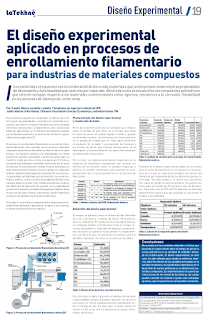Tomado de:https://www.itm.edu.co/wp-content/uploads/la-tekhne/2019/PDF-La-Tekhne-No.-104-Agosto-de-2019_compressed.pdf
The experimental design applied in filamentary winding processes for composite materials industries
Julián Alberto Uribe Gómez
Composite materials are the combination of two or more materials that together provide better performance properties and functionality than each one separately. Among these materials are polymeric compounds that are composed of polymers that offer advantages over conventional materials such as: lightness, corrosion resistance, flexibility in manufacturing processes, among others
These polymers can be combined with fibers, in order to improve their properties and become composite materials, which cover a spectrum of applications ranging from structural and architectural elements for construction to applications in the aerospace industry, through the automotive industry, the construction of ships or wind power generators [1].
The filamentary winding process is one of the best known manufacturing methods with the use of glass fiber reinforced polymer composite materials, in this process, continuous reinforcements are impregnated with polymeric resin at high speeds and precisely on a mandrel or mold that rotates around its axis of rotation [1]. This process is highly automated and controlled, less labor intensive than other processes by molding. This produces laminates with high strength-to-weight ratios and can be used to produce parts with high mechanical demands [2]. The structures that can be manufactured are of revolution, with cylindrical, spherical, conical symmetry or with geodesic shapes [2] such as pipes, tanks and posts. This method has two different manufacturing conditions according to the process capacity of the company and the objective of the parts to be manufactured, these forms are continuous and discontinuous, where the difference is based on the possible forms of winding.
Figure 1 shows the basic scheme of the batch filamentary winding process, Figure 2 shows the process continuously.
Approach to experimental design and data collection
The experimental design approach starts with the identification of the variables that influence gel time. This is the time it takes for the resin to move from a liquid to a solid state and the piece is shaped, becoming practically the working time it takes to form the product. Table 1 shows the factors and factor levels that directly influence the performance and functionality of a piece manufactured by filamentary winding.
Therefore, the main objectives required in the composite materials industry are: to evaluate the effects of the factors on the response variable and to propose a mathematical model to predict the behavior of the polymeric resin in the manufacturing process.
Development of the experimental design
The experiment was proposed as a 3 ^ k Box-Behnken design with 4 factors and 3 factor levels. For this design, 81 combinations of experiments were proposed, however, due to experimental limitations, such as the time, available resources and viability of some combinations, the design was optimized to obtain 16 experiments. Based on that, the effects on the response variable were calculated, as shown in Table 2.
On the other hand, table 3 presents the analysis of variance or ANOVA table, where you can see which factors have a statistically significant effect on gel time, in this case, 5 factors have P-values less than 0.05, these They are the main individual design factors.
Finally, the experimental design must be an input for decision making in industry and manufacturing, so it is important to predict gel time values, depending on the different stakeholders. In this aspect, there are two scenarios (see table 4), where it is requested to predict the optimal points for a time of 20 minutes and another of 40 minutes. In this case, R ^ 2 = 93,747 obtained in the experimental design explains how tight the model is and its reliability.
Conclusions
According to the results obtained, the factor that has a greater positive effect on the gel time of the polymeric resin is the amount of inhibitor used in manufacturing and, conversely, the other factors have negative effects on the response variable.
It is important to take into account the interactions according to the combination of the levels of the factors that are random, but the best or the most complicated options of each of them can coincide, which in practice would not be performed.

No hay comentarios.:
Publicar un comentario